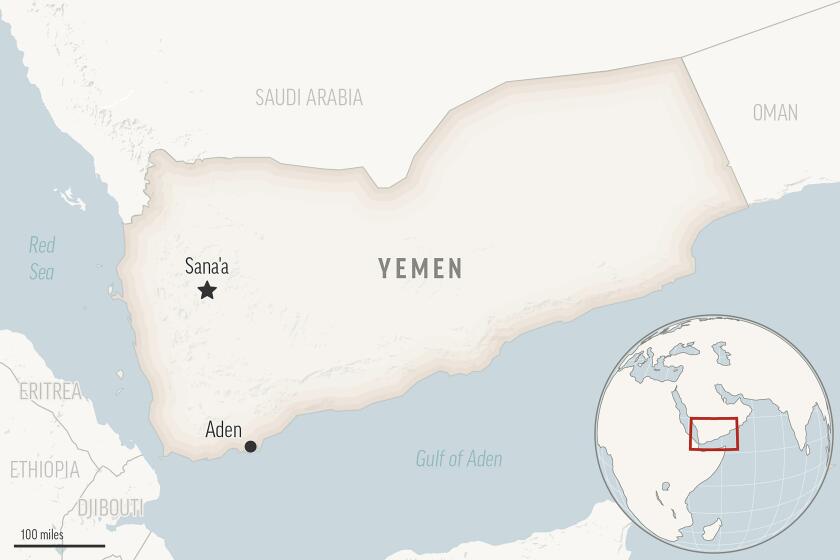Drab City Brightens : Marx Yields to Christmas in East Berlin
- Share via
EAST BERLIN — Despite the theory that religion would fade away under communism, East Germany’s Marxist-Leninist regime has not eradicated Christmas, and the trappings of the season are all over this city east of the Berlin Wall.
From the air on a clear, cold night, travelers can see the four-story outline of a neon Christmas tree on the side of a department store on the Alexanderplatz. And an evergreen tree, sparsely decorated with ornaments and lights, greets passengers descending into East Berlin from the elevated train at the Friedrichstrasse station.
Store Windows Decorated
Unter den Linden, East Berlin’s famed boulevard, is festooned with overhead lights, and nearly every store window along major streets has a Christmas decoration of some kind, brightening the usually drab city. Even East Berlin officials have felt the urge to decorate, having put up three 40-foot Christmas trees--one outside the City Hall, the others in public squares.
“The East Germans have decided that you can’t beat Christmas,” a Western diplomat commented. Christian churches are not as strong in East Germany as they are in Poland and Hungary, but both Roman Catholic and Protestant churches have significant followings here. Officials say that 7 million of East Germany’s 17 million people describe themselves as Christian.
“The churches play a strong role in acting as a safety valve,” one East Berlin resident said. “They are a kind of loyal opposition.”
There is no official restriction by the Communist authorities on the observance of Christmas, and religious services are scheduled throughout the city.
Germans traditionally exchange gifts on Christmas Eve, and Dec. 25 and 26 are national holidays on both sides of the Berlin Wall. But more is made of the holiday season in West Berlin. Bars and discos are open until 5 or 6 a.m., and they are packed.
The one area of West Berlin where Christmas celebrations are not taking precedence over everything else at the moment is the Turkish working-class district of Kruezberg. The proprietor of a kebab restaurant there said: “We’re Muslims, so Christmas has no religious significance for us. But we like the two days’ holiday.”
In West Berlin this Christmas, there are more decorations, and the streets are filled with people, in contrast with the relatively few strollers to be seen in East Berlin.
Christmas trees are everywhere for, as authorities note, the modern Christmas tree originated in Germany, although trees were worshiped in pagan times throughout northern Europe and Scandinavia.
‘Paradise Tree’
In the old days in Germany, a fir tree, decorated with apples, represented the Garden of Eden and was known as a “paradise tree.” It would be set up in homes on Dec. 24 and also hung with communion wafers.
The wafers eventually gave way to cookies, and candles were added as a symbol of Christ. There was also a construction known as the Christmas pyramid that held holy figurines and was decorated with evergreens. By the 16th Century, the pyramid and paradise tree had merged, becoming the present-day Christmas tree. German settlers took the Christmas tree to the United States, and they also became tremendously popular in Britain, with support from Queen Victoria and her consort, Prince Albert.
Bitter Winter of 1945
In East Berlin, evergreens decorate private homes as well as public places and churches, like St. Hedwige’s Cathedral. Inside the Catholic cathedral the other day, the custodian remembered the first postwar Christmas, in 1945, when Berliners were half-starved and freezing in the bitter winter.
That was when CARE relief began, and every German was familiar with the initials, though few knew that they stood for Cooperative for American Remittances to Everywhere. (The name has since been changed to Cooperative for American Relief Everywhere.)
To most people here, CARE meant a 13-kilogram (28.6-pound) package containing corned beef, powdered milk, wheat flour, bacon, coffee, peanut butter, sugar and chocolate--enough for one person for a month.
St. Hedwige’s custodian declared: “It was a cruel, cruel time. If it were not for the Americans and for the Lord, we would not have survived.”
‘Millions of Lives Saved’
“CARE saved millions of German lives,” the late German Chancellor Konrad Adenauer once said. “It was the most generous gesture a victor has ever made to a vanquished people. Our gratitude to the Americans for their help will never die.”
Forty years later, East Berlin is able to celebrate a Christmas with everyone properly fed, clothed and housed, although as one resident put it, “There is everything over here that you find in the West, but less of it.”
Not far away from the cathedral, at the Ermeler Haus, an old, high-ceilinged, elegant restaurant on the banks of the Spree River, a uniformed U.S. Army lieutenant dined with his wife, also a first lieutenant and also in uniform.
“We’re based in Wurzburg, in West Germany,” he said, as a dazzling sunset glowed outside the windows. “We thought we’d come to Berlin for Christmas to see what it’s like.
“You know, on duty, . . . we are always looking across the wall and planning to defend ourselves against the East Germans and the Soviets. Now, suddenly, we’re here, surrounded by the other side. It’s kind of a strange feeling.”
--- UNPUBLISHED NOTE ---
CARE, at its founding in 1945, stood for the Cooperative for American Remittances to Europe. The name was later changed to Cooperative for American Remittances Everywhere.
--- END NOTE ---
More to Read
Sign up for Essential California
The most important California stories and recommendations in your inbox every morning.
You may occasionally receive promotional content from the Los Angeles Times.













